Business Strategy Report: Detailed Analysis of Aldi Company's Strategy
VerifiedAdded on 2020/07/23
|19
|5113
|46
Report
AI Summary
This report offers a comprehensive analysis of Aldi's business strategy. It begins with an introduction to business strategy and then delves into Aldi's mission, vision, objectives, goals, and core competencies. The report examines factors influencing Aldi's strategic plan, evaluates strategic planning techniques like the BCG matrix and SPACE matrix, and provides a detailed SWOT analysis. Furthermore, it explores Porter's five forces, stakeholder analysis, and new strategies using Mendelow's matrix. The report also assesses alternative strategies related to growth and market entry. It concludes by discussing the roles and responsibilities of personnel, resource analysis, and the use of SMART targets, providing a holistic view of Aldi's strategic approach.
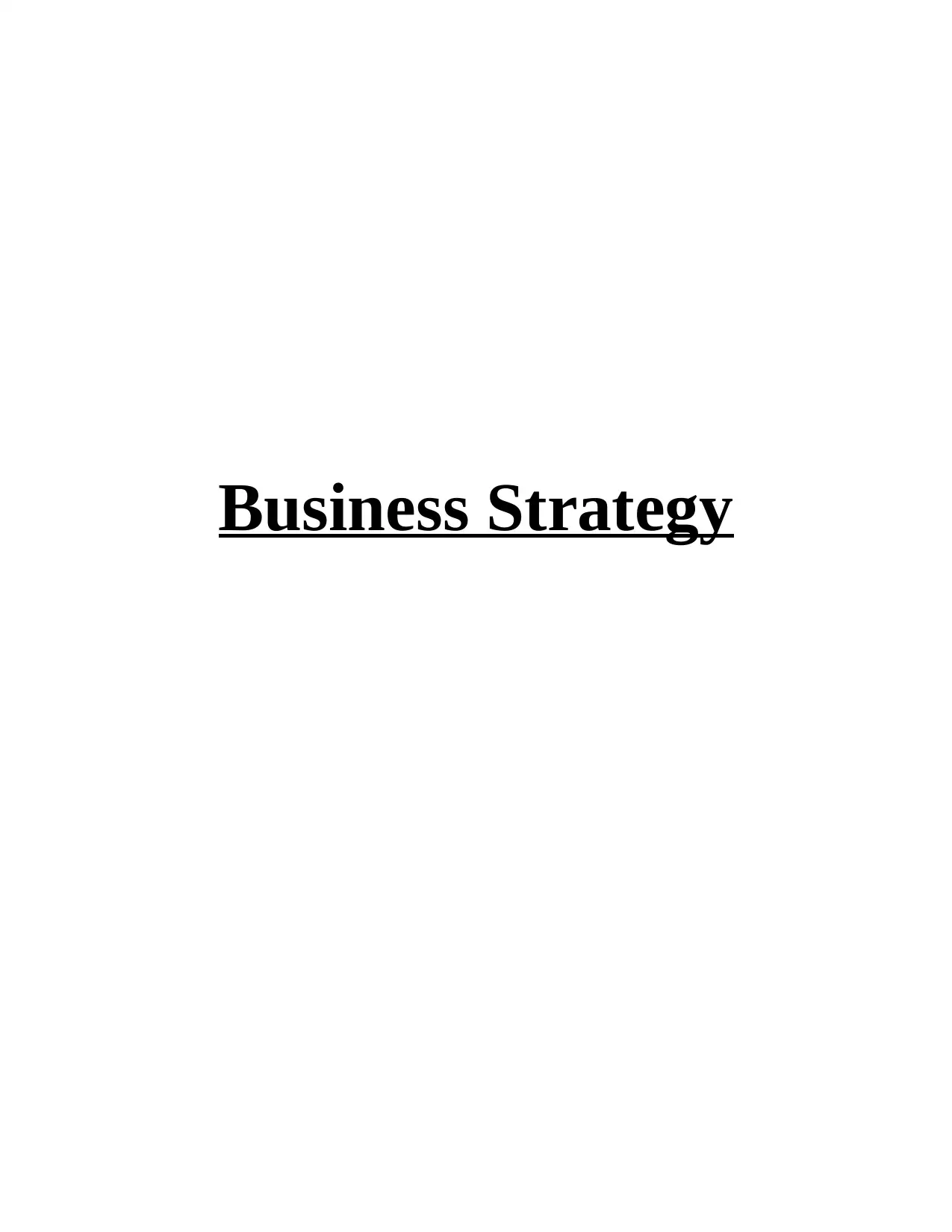
Business Strategy
Paraphrase This Document
Need a fresh take? Get an instant paraphrase of this document with our AI Paraphraser
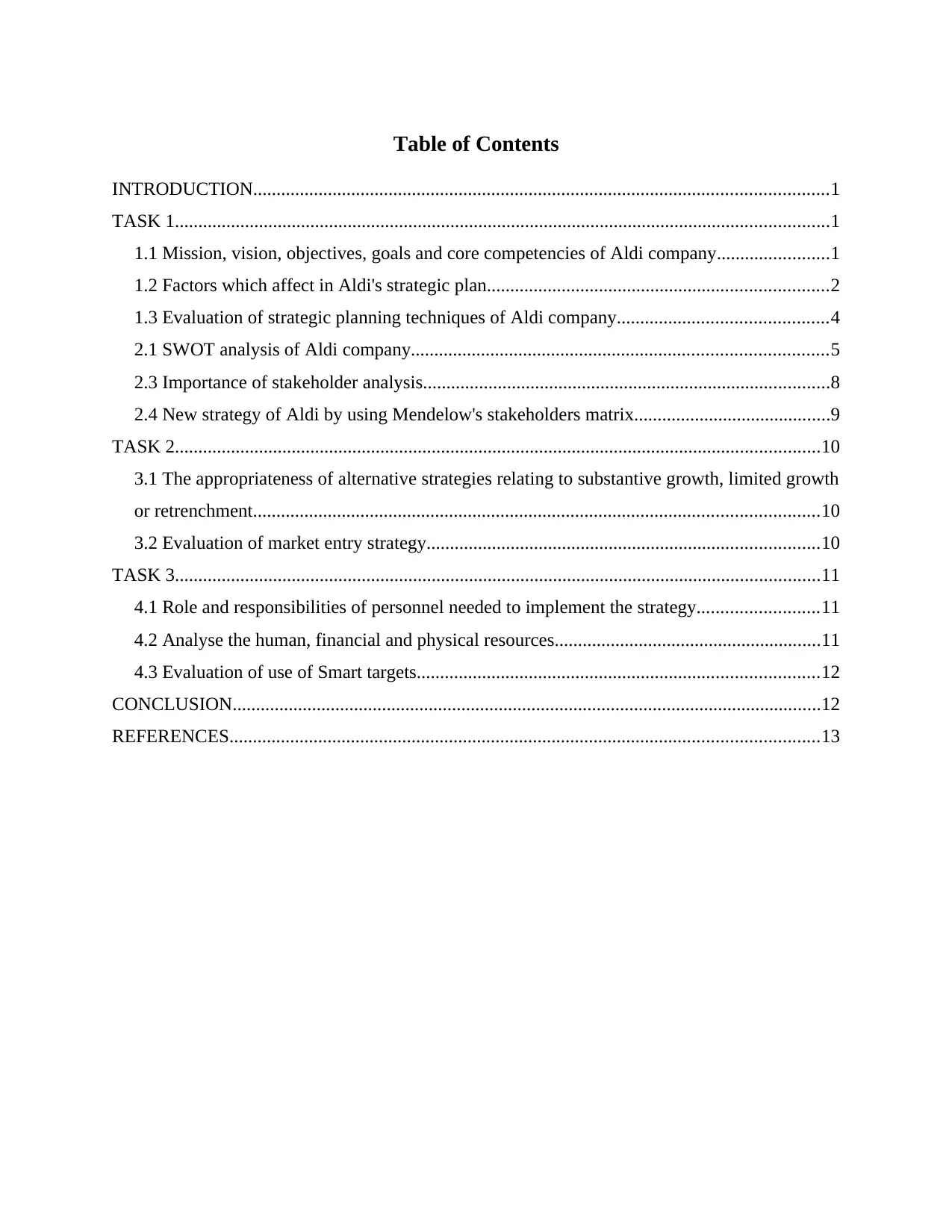
Table of Contents
INTRODUCTION...........................................................................................................................1
TASK 1............................................................................................................................................1
1.1 Mission, vision, objectives, goals and core competencies of Aldi company........................1
1.2 Factors which affect in Aldi's strategic plan.........................................................................2
1.3 Evaluation of strategic planning techniques of Aldi company.............................................4
2.1 SWOT analysis of Aldi company.........................................................................................5
2.3 Importance of stakeholder analysis.......................................................................................8
2.4 New strategy of Aldi by using Mendelow's stakeholders matrix..........................................9
TASK 2..........................................................................................................................................10
3.1 The appropriateness of alternative strategies relating to substantive growth, limited growth
or retrenchment.........................................................................................................................10
3.2 Evaluation of market entry strategy....................................................................................10
TASK 3..........................................................................................................................................11
4.1 Role and responsibilities of personnel needed to implement the strategy..........................11
4.2 Analyse the human, financial and physical resources.........................................................11
4.3 Evaluation of use of Smart targets......................................................................................12
CONCLUSION..............................................................................................................................12
REFERENCES..............................................................................................................................13
INTRODUCTION...........................................................................................................................1
TASK 1............................................................................................................................................1
1.1 Mission, vision, objectives, goals and core competencies of Aldi company........................1
1.2 Factors which affect in Aldi's strategic plan.........................................................................2
1.3 Evaluation of strategic planning techniques of Aldi company.............................................4
2.1 SWOT analysis of Aldi company.........................................................................................5
2.3 Importance of stakeholder analysis.......................................................................................8
2.4 New strategy of Aldi by using Mendelow's stakeholders matrix..........................................9
TASK 2..........................................................................................................................................10
3.1 The appropriateness of alternative strategies relating to substantive growth, limited growth
or retrenchment.........................................................................................................................10
3.2 Evaluation of market entry strategy....................................................................................10
TASK 3..........................................................................................................................................11
4.1 Role and responsibilities of personnel needed to implement the strategy..........................11
4.2 Analyse the human, financial and physical resources.........................................................11
4.3 Evaluation of use of Smart targets......................................................................................12
CONCLUSION..............................................................................................................................12
REFERENCES..............................................................................................................................13
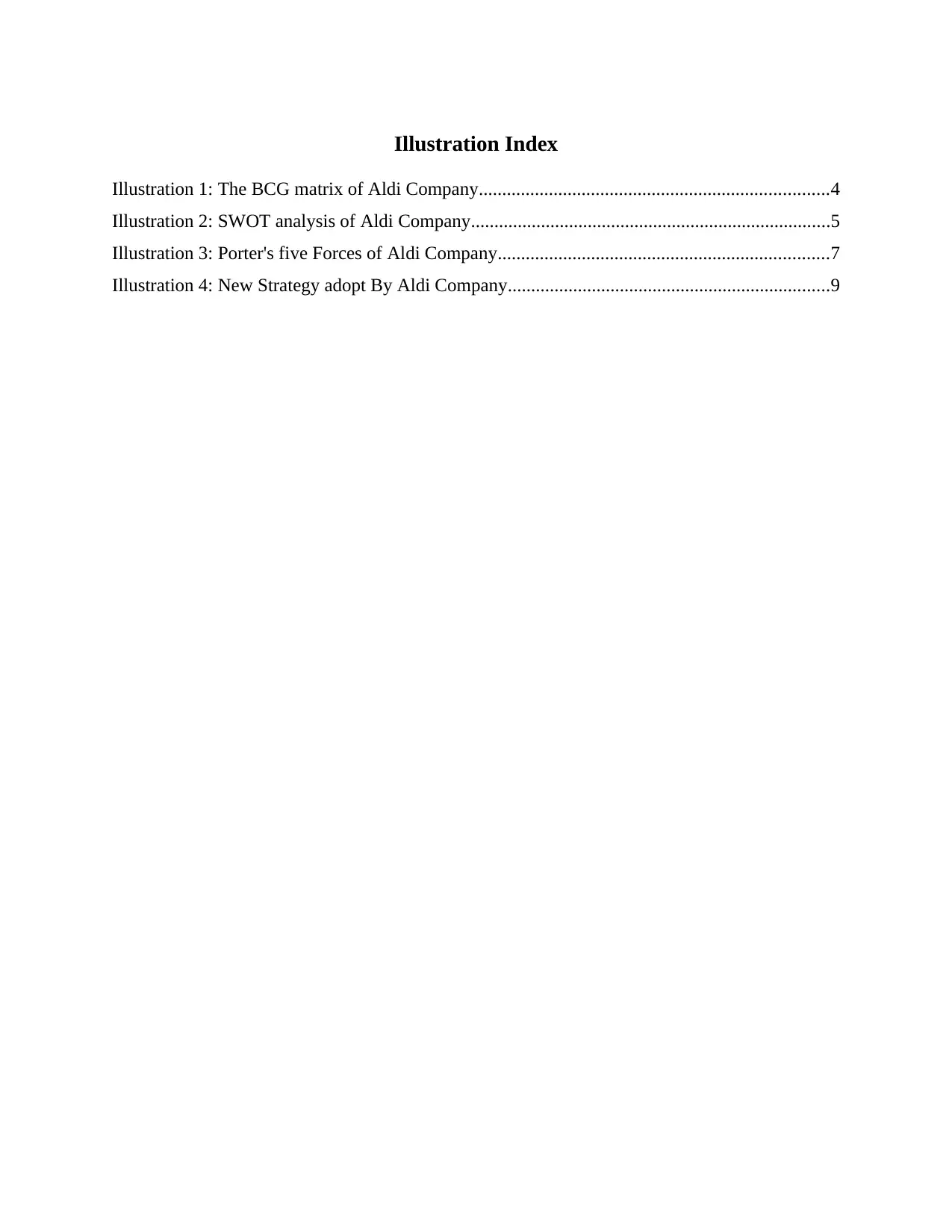
Illustration Index
Illustration 1: The BCG matrix of Aldi Company...........................................................................4
Illustration 2: SWOT analysis of Aldi Company.............................................................................5
Illustration 3: Porter's five Forces of Aldi Company.......................................................................7
Illustration 4: New Strategy adopt By Aldi Company.....................................................................9
Illustration 1: The BCG matrix of Aldi Company...........................................................................4
Illustration 2: SWOT analysis of Aldi Company.............................................................................5
Illustration 3: Porter's five Forces of Aldi Company.......................................................................7
Illustration 4: New Strategy adopt By Aldi Company.....................................................................9
⊘ This is a preview!⊘
Do you want full access?
Subscribe today to unlock all pages.

Trusted by 1+ million students worldwide
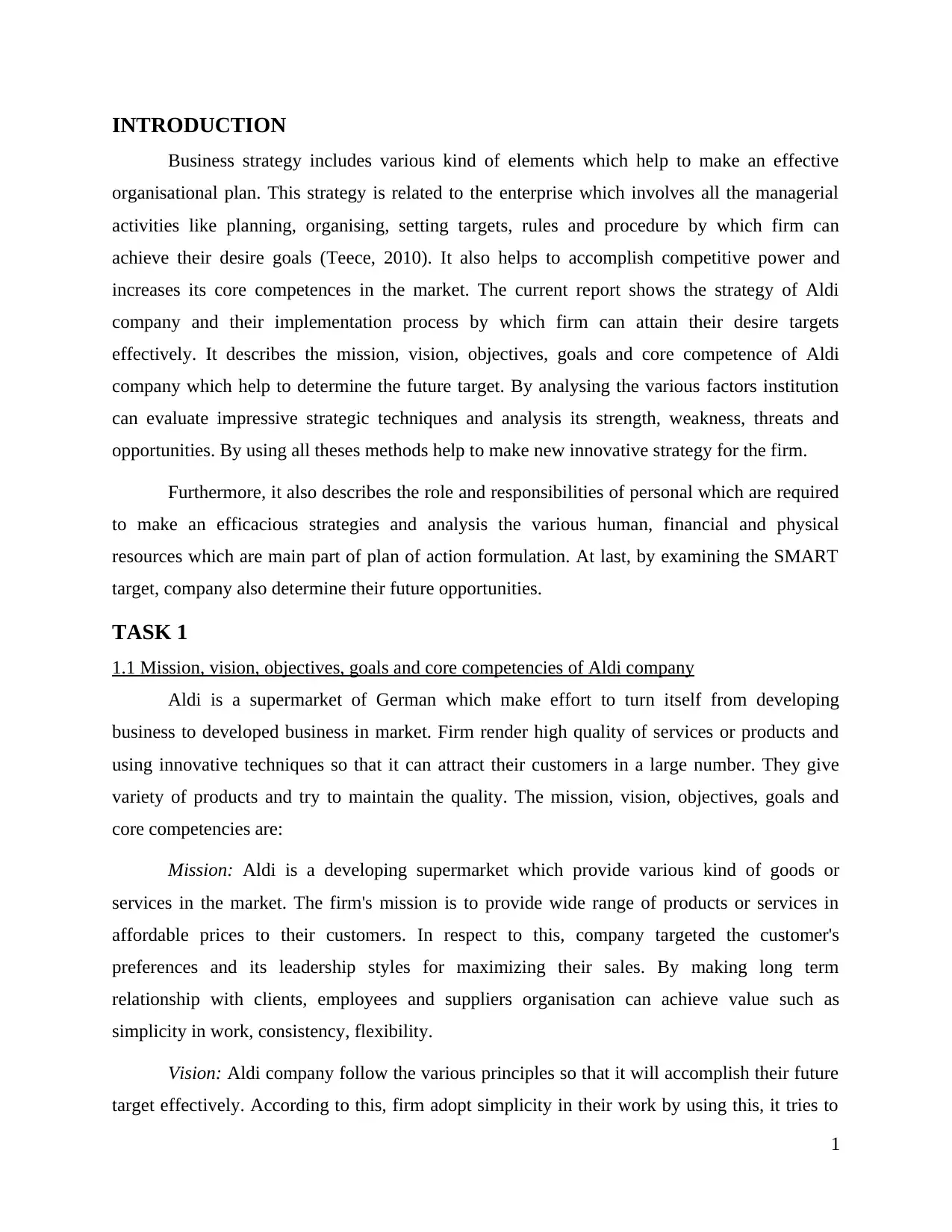
INTRODUCTION
Business strategy includes various kind of elements which help to make an effective
organisational plan. This strategy is related to the enterprise which involves all the managerial
activities like planning, organising, setting targets, rules and procedure by which firm can
achieve their desire goals (Teece, 2010). It also helps to accomplish competitive power and
increases its core competences in the market. The current report shows the strategy of Aldi
company and their implementation process by which firm can attain their desire targets
effectively. It describes the mission, vision, objectives, goals and core competence of Aldi
company which help to determine the future target. By analysing the various factors institution
can evaluate impressive strategic techniques and analysis its strength, weakness, threats and
opportunities. By using all theses methods help to make new innovative strategy for the firm.
Furthermore, it also describes the role and responsibilities of personal which are required
to make an efficacious strategies and analysis the various human, financial and physical
resources which are main part of plan of action formulation. At last, by examining the SMART
target, company also determine their future opportunities.
TASK 1
1.1 Mission, vision, objectives, goals and core competencies of Aldi company
Aldi is a supermarket of German which make effort to turn itself from developing
business to developed business in market. Firm render high quality of services or products and
using innovative techniques so that it can attract their customers in a large number. They give
variety of products and try to maintain the quality. The mission, vision, objectives, goals and
core competencies are:
Mission: Aldi is a developing supermarket which provide various kind of goods or
services in the market. The firm's mission is to provide wide range of products or services in
affordable prices to their customers. In respect to this, company targeted the customer's
preferences and its leadership styles for maximizing their sales. By making long term
relationship with clients, employees and suppliers organisation can achieve value such as
simplicity in work, consistency, flexibility.
Vision: Aldi company follow the various principles so that it will accomplish their future
target effectively. According to this, firm adopt simplicity in their work by using this, it tries to
1
Business strategy includes various kind of elements which help to make an effective
organisational plan. This strategy is related to the enterprise which involves all the managerial
activities like planning, organising, setting targets, rules and procedure by which firm can
achieve their desire goals (Teece, 2010). It also helps to accomplish competitive power and
increases its core competences in the market. The current report shows the strategy of Aldi
company and their implementation process by which firm can attain their desire targets
effectively. It describes the mission, vision, objectives, goals and core competence of Aldi
company which help to determine the future target. By analysing the various factors institution
can evaluate impressive strategic techniques and analysis its strength, weakness, threats and
opportunities. By using all theses methods help to make new innovative strategy for the firm.
Furthermore, it also describes the role and responsibilities of personal which are required
to make an efficacious strategies and analysis the various human, financial and physical
resources which are main part of plan of action formulation. At last, by examining the SMART
target, company also determine their future opportunities.
TASK 1
1.1 Mission, vision, objectives, goals and core competencies of Aldi company
Aldi is a supermarket of German which make effort to turn itself from developing
business to developed business in market. Firm render high quality of services or products and
using innovative techniques so that it can attract their customers in a large number. They give
variety of products and try to maintain the quality. The mission, vision, objectives, goals and
core competencies are:
Mission: Aldi is a developing supermarket which provide various kind of goods or
services in the market. The firm's mission is to provide wide range of products or services in
affordable prices to their customers. In respect to this, company targeted the customer's
preferences and its leadership styles for maximizing their sales. By making long term
relationship with clients, employees and suppliers organisation can achieve value such as
simplicity in work, consistency, flexibility.
Vision: Aldi company follow the various principles so that it will accomplish their future
target effectively. According to this, firm adopt simplicity in their work by using this, it tries to
1
Paraphrase This Document
Need a fresh take? Get an instant paraphrase of this document with our AI Paraphraser
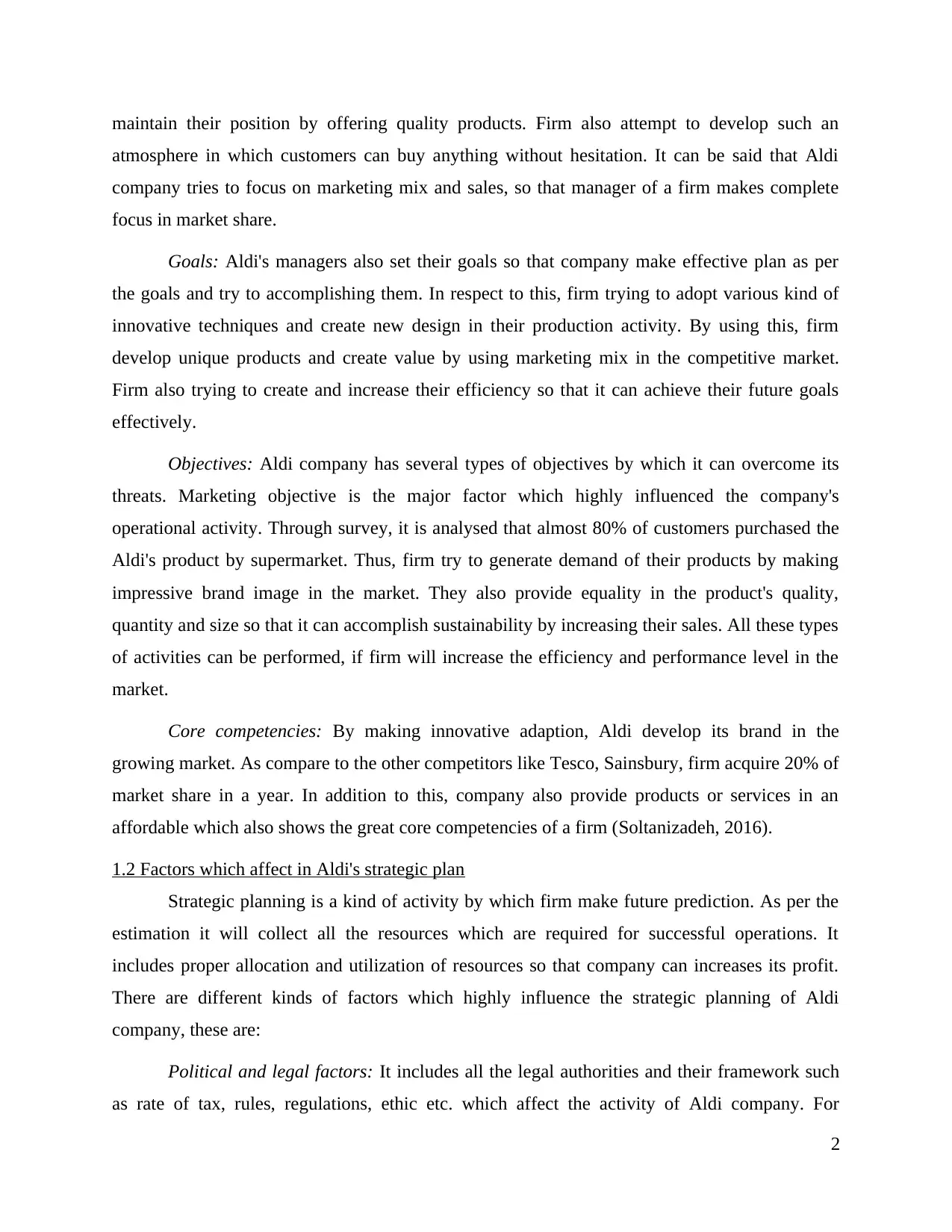
maintain their position by offering quality products. Firm also attempt to develop such an
atmosphere in which customers can buy anything without hesitation. It can be said that Aldi
company tries to focus on marketing mix and sales, so that manager of a firm makes complete
focus in market share.
Goals: Aldi's managers also set their goals so that company make effective plan as per
the goals and try to accomplishing them. In respect to this, firm trying to adopt various kind of
innovative techniques and create new design in their production activity. By using this, firm
develop unique products and create value by using marketing mix in the competitive market.
Firm also trying to create and increase their efficiency so that it can achieve their future goals
effectively.
Objectives: Aldi company has several types of objectives by which it can overcome its
threats. Marketing objective is the major factor which highly influenced the company's
operational activity. Through survey, it is analysed that almost 80% of customers purchased the
Aldi's product by supermarket. Thus, firm try to generate demand of their products by making
impressive brand image in the market. They also provide equality in the product's quality,
quantity and size so that it can accomplish sustainability by increasing their sales. All these types
of activities can be performed, if firm will increase the efficiency and performance level in the
market.
Core competencies: By making innovative adaption, Aldi develop its brand in the
growing market. As compare to the other competitors like Tesco, Sainsbury, firm acquire 20% of
market share in a year. In addition to this, company also provide products or services in an
affordable which also shows the great core competencies of a firm (Soltanizadeh, 2016).
1.2 Factors which affect in Aldi's strategic plan
Strategic planning is a kind of activity by which firm make future prediction. As per the
estimation it will collect all the resources which are required for successful operations. It
includes proper allocation and utilization of resources so that company can increases its profit.
There are different kinds of factors which highly influence the strategic planning of Aldi
company, these are:
Political and legal factors: It includes all the legal authorities and their framework such
as rate of tax, rules, regulations, ethic etc. which affect the activity of Aldi company. For
2
atmosphere in which customers can buy anything without hesitation. It can be said that Aldi
company tries to focus on marketing mix and sales, so that manager of a firm makes complete
focus in market share.
Goals: Aldi's managers also set their goals so that company make effective plan as per
the goals and try to accomplishing them. In respect to this, firm trying to adopt various kind of
innovative techniques and create new design in their production activity. By using this, firm
develop unique products and create value by using marketing mix in the competitive market.
Firm also trying to create and increase their efficiency so that it can achieve their future goals
effectively.
Objectives: Aldi company has several types of objectives by which it can overcome its
threats. Marketing objective is the major factor which highly influenced the company's
operational activity. Through survey, it is analysed that almost 80% of customers purchased the
Aldi's product by supermarket. Thus, firm try to generate demand of their products by making
impressive brand image in the market. They also provide equality in the product's quality,
quantity and size so that it can accomplish sustainability by increasing their sales. All these types
of activities can be performed, if firm will increase the efficiency and performance level in the
market.
Core competencies: By making innovative adaption, Aldi develop its brand in the
growing market. As compare to the other competitors like Tesco, Sainsbury, firm acquire 20% of
market share in a year. In addition to this, company also provide products or services in an
affordable which also shows the great core competencies of a firm (Soltanizadeh, 2016).
1.2 Factors which affect in Aldi's strategic plan
Strategic planning is a kind of activity by which firm make future prediction. As per the
estimation it will collect all the resources which are required for successful operations. It
includes proper allocation and utilization of resources so that company can increases its profit.
There are different kinds of factors which highly influence the strategic planning of Aldi
company, these are:
Political and legal factors: It includes all the legal authorities and their framework such
as rate of tax, rules, regulations, ethic etc. which affect the activity of Aldi company. For
2
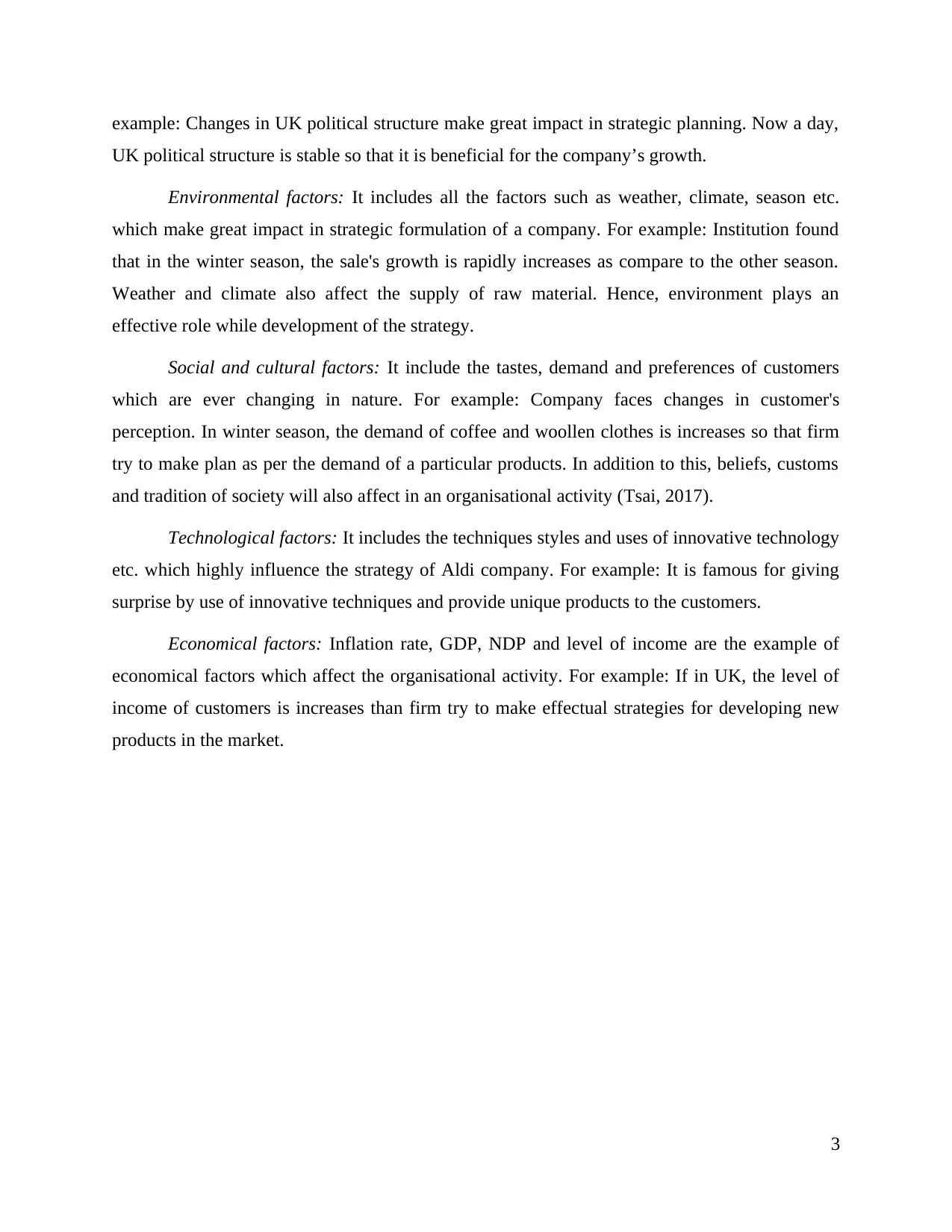
example: Changes in UK political structure make great impact in strategic planning. Now a day,
UK political structure is stable so that it is beneficial for the company’s growth.
Environmental factors: It includes all the factors such as weather, climate, season etc.
which make great impact in strategic formulation of a company. For example: Institution found
that in the winter season, the sale's growth is rapidly increases as compare to the other season.
Weather and climate also affect the supply of raw material. Hence, environment plays an
effective role while development of the strategy.
Social and cultural factors: It include the tastes, demand and preferences of customers
which are ever changing in nature. For example: Company faces changes in customer's
perception. In winter season, the demand of coffee and woollen clothes is increases so that firm
try to make plan as per the demand of a particular products. In addition to this, beliefs, customs
and tradition of society will also affect in an organisational activity (Tsai, 2017).
Technological factors: It includes the techniques styles and uses of innovative technology
etc. which highly influence the strategy of Aldi company. For example: It is famous for giving
surprise by use of innovative techniques and provide unique products to the customers.
Economical factors: Inflation rate, GDP, NDP and level of income are the example of
economical factors which affect the organisational activity. For example: If in UK, the level of
income of customers is increases than firm try to make effectual strategies for developing new
products in the market.
3
UK political structure is stable so that it is beneficial for the company’s growth.
Environmental factors: It includes all the factors such as weather, climate, season etc.
which make great impact in strategic formulation of a company. For example: Institution found
that in the winter season, the sale's growth is rapidly increases as compare to the other season.
Weather and climate also affect the supply of raw material. Hence, environment plays an
effective role while development of the strategy.
Social and cultural factors: It include the tastes, demand and preferences of customers
which are ever changing in nature. For example: Company faces changes in customer's
perception. In winter season, the demand of coffee and woollen clothes is increases so that firm
try to make plan as per the demand of a particular products. In addition to this, beliefs, customs
and tradition of society will also affect in an organisational activity (Tsai, 2017).
Technological factors: It includes the techniques styles and uses of innovative technology
etc. which highly influence the strategy of Aldi company. For example: It is famous for giving
surprise by use of innovative techniques and provide unique products to the customers.
Economical factors: Inflation rate, GDP, NDP and level of income are the example of
economical factors which affect the organisational activity. For example: If in UK, the level of
income of customers is increases than firm try to make effectual strategies for developing new
products in the market.
3
⊘ This is a preview!⊘
Do you want full access?
Subscribe today to unlock all pages.

Trusted by 1+ million students worldwide
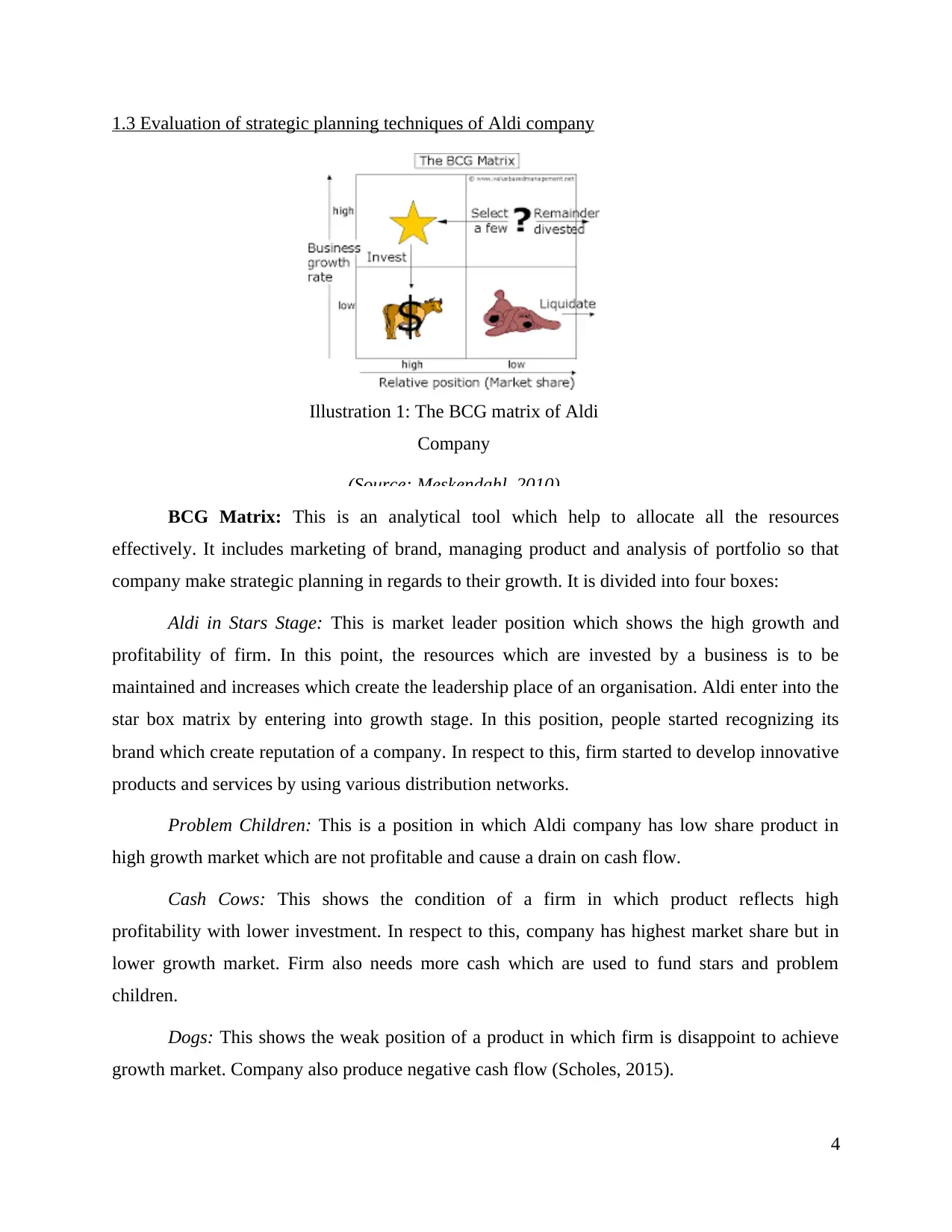
1.3 Evaluation of strategic planning techniques of Aldi company
Illustration 1: The BCG matrix of Aldi
Company
(Source: Meskendahl, 2010)
BCG Matrix: This is an analytical tool which help to allocate all the resources
effectively. It includes marketing of brand, managing product and analysis of portfolio so that
company make strategic planning in regards to their growth. It is divided into four boxes:
Aldi in Stars Stage: This is market leader position which shows the high growth and
profitability of firm. In this point, the resources which are invested by a business is to be
maintained and increases which create the leadership place of an organisation. Aldi enter into the
star box matrix by entering into growth stage. In this position, people started recognizing its
brand which create reputation of a company. In respect to this, firm started to develop innovative
products and services by using various distribution networks.
Problem Children: This is a position in which Aldi company has low share product in
high growth market which are not profitable and cause a drain on cash flow.
Cash Cows: This shows the condition of a firm in which product reflects high
profitability with lower investment. In respect to this, company has highest market share but in
lower growth market. Firm also needs more cash which are used to fund stars and problem
children.
Dogs: This shows the weak position of a product in which firm is disappoint to achieve
growth market. Company also produce negative cash flow (Scholes, 2015).
4
Illustration 1: The BCG matrix of Aldi
Company
(Source: Meskendahl, 2010)
BCG Matrix: This is an analytical tool which help to allocate all the resources
effectively. It includes marketing of brand, managing product and analysis of portfolio so that
company make strategic planning in regards to their growth. It is divided into four boxes:
Aldi in Stars Stage: This is market leader position which shows the high growth and
profitability of firm. In this point, the resources which are invested by a business is to be
maintained and increases which create the leadership place of an organisation. Aldi enter into the
star box matrix by entering into growth stage. In this position, people started recognizing its
brand which create reputation of a company. In respect to this, firm started to develop innovative
products and services by using various distribution networks.
Problem Children: This is a position in which Aldi company has low share product in
high growth market which are not profitable and cause a drain on cash flow.
Cash Cows: This shows the condition of a firm in which product reflects high
profitability with lower investment. In respect to this, company has highest market share but in
lower growth market. Firm also needs more cash which are used to fund stars and problem
children.
Dogs: This shows the weak position of a product in which firm is disappoint to achieve
growth market. Company also produce negative cash flow (Scholes, 2015).
4
Paraphrase This Document
Need a fresh take? Get an instant paraphrase of this document with our AI Paraphraser
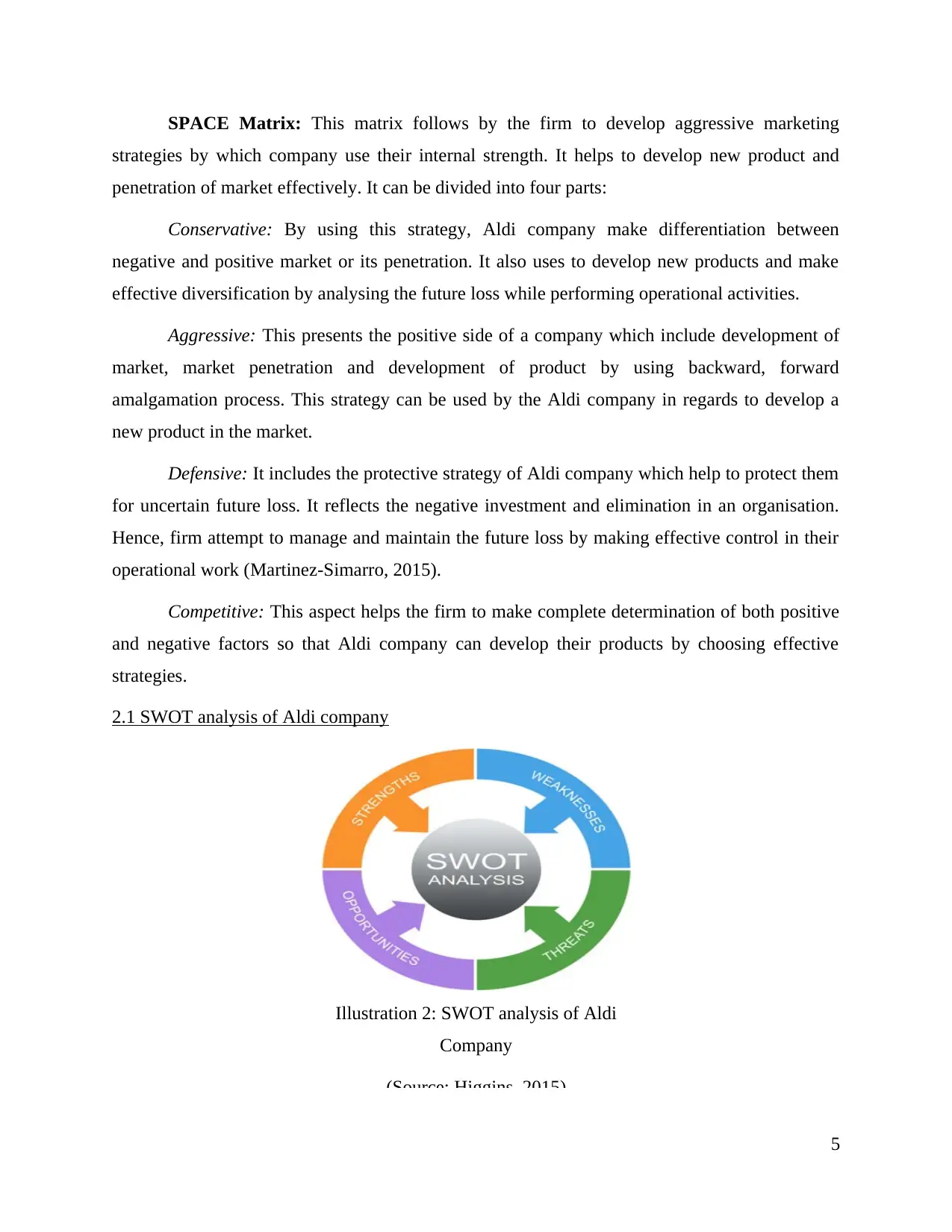
SPACE Matrix: This matrix follows by the firm to develop aggressive marketing
strategies by which company use their internal strength. It helps to develop new product and
penetration of market effectively. It can be divided into four parts:
Conservative: By using this strategy, Aldi company make differentiation between
negative and positive market or its penetration. It also uses to develop new products and make
effective diversification by analysing the future loss while performing operational activities.
Aggressive: This presents the positive side of a company which include development of
market, market penetration and development of product by using backward, forward
amalgamation process. This strategy can be used by the Aldi company in regards to develop a
new product in the market.
Defensive: It includes the protective strategy of Aldi company which help to protect them
for uncertain future loss. It reflects the negative investment and elimination in an organisation.
Hence, firm attempt to manage and maintain the future loss by making effective control in their
operational work (Martinez-Simarro, 2015).
Competitive: This aspect helps the firm to make complete determination of both positive
and negative factors so that Aldi company can develop their products by choosing effective
strategies.
2.1 SWOT analysis of Aldi company
Illustration 2: SWOT analysis of Aldi
Company
(Source: Higgins, 2015)
5
strategies by which company use their internal strength. It helps to develop new product and
penetration of market effectively. It can be divided into four parts:
Conservative: By using this strategy, Aldi company make differentiation between
negative and positive market or its penetration. It also uses to develop new products and make
effective diversification by analysing the future loss while performing operational activities.
Aggressive: This presents the positive side of a company which include development of
market, market penetration and development of product by using backward, forward
amalgamation process. This strategy can be used by the Aldi company in regards to develop a
new product in the market.
Defensive: It includes the protective strategy of Aldi company which help to protect them
for uncertain future loss. It reflects the negative investment and elimination in an organisation.
Hence, firm attempt to manage and maintain the future loss by making effective control in their
operational work (Martinez-Simarro, 2015).
Competitive: This aspect helps the firm to make complete determination of both positive
and negative factors so that Aldi company can develop their products by choosing effective
strategies.
2.1 SWOT analysis of Aldi company
Illustration 2: SWOT analysis of Aldi
Company
(Source: Higgins, 2015)
5
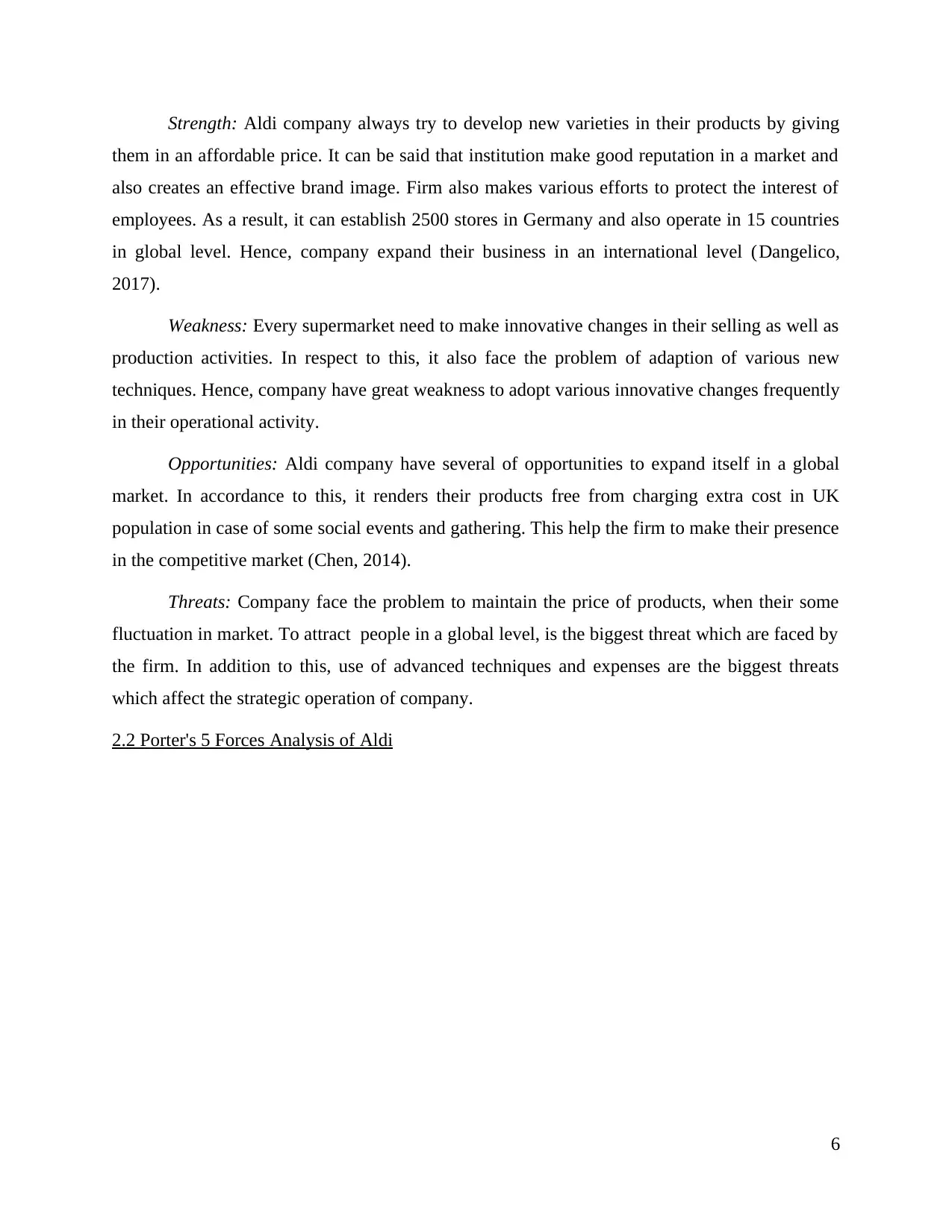
Strength: Aldi company always try to develop new varieties in their products by giving
them in an affordable price. It can be said that institution make good reputation in a market and
also creates an effective brand image. Firm also makes various efforts to protect the interest of
employees. As a result, it can establish 2500 stores in Germany and also operate in 15 countries
in global level. Hence, company expand their business in an international level (Dangelico,
2017).
Weakness: Every supermarket need to make innovative changes in their selling as well as
production activities. In respect to this, it also face the problem of adaption of various new
techniques. Hence, company have great weakness to adopt various innovative changes frequently
in their operational activity.
Opportunities: Aldi company have several of opportunities to expand itself in a global
market. In accordance to this, it renders their products free from charging extra cost in UK
population in case of some social events and gathering. This help the firm to make their presence
in the competitive market (Chen, 2014).
Threats: Company face the problem to maintain the price of products, when their some
fluctuation in market. To attract people in a global level, is the biggest threat which are faced by
the firm. In addition to this, use of advanced techniques and expenses are the biggest threats
which affect the strategic operation of company.
2.2 Porter's 5 Forces Analysis of Aldi
6
them in an affordable price. It can be said that institution make good reputation in a market and
also creates an effective brand image. Firm also makes various efforts to protect the interest of
employees. As a result, it can establish 2500 stores in Germany and also operate in 15 countries
in global level. Hence, company expand their business in an international level (Dangelico,
2017).
Weakness: Every supermarket need to make innovative changes in their selling as well as
production activities. In respect to this, it also face the problem of adaption of various new
techniques. Hence, company have great weakness to adopt various innovative changes frequently
in their operational activity.
Opportunities: Aldi company have several of opportunities to expand itself in a global
market. In accordance to this, it renders their products free from charging extra cost in UK
population in case of some social events and gathering. This help the firm to make their presence
in the competitive market (Chen, 2014).
Threats: Company face the problem to maintain the price of products, when their some
fluctuation in market. To attract people in a global level, is the biggest threat which are faced by
the firm. In addition to this, use of advanced techniques and expenses are the biggest threats
which affect the strategic operation of company.
2.2 Porter's 5 Forces Analysis of Aldi
6
⊘ This is a preview!⊘
Do you want full access?
Subscribe today to unlock all pages.

Trusted by 1+ million students worldwide
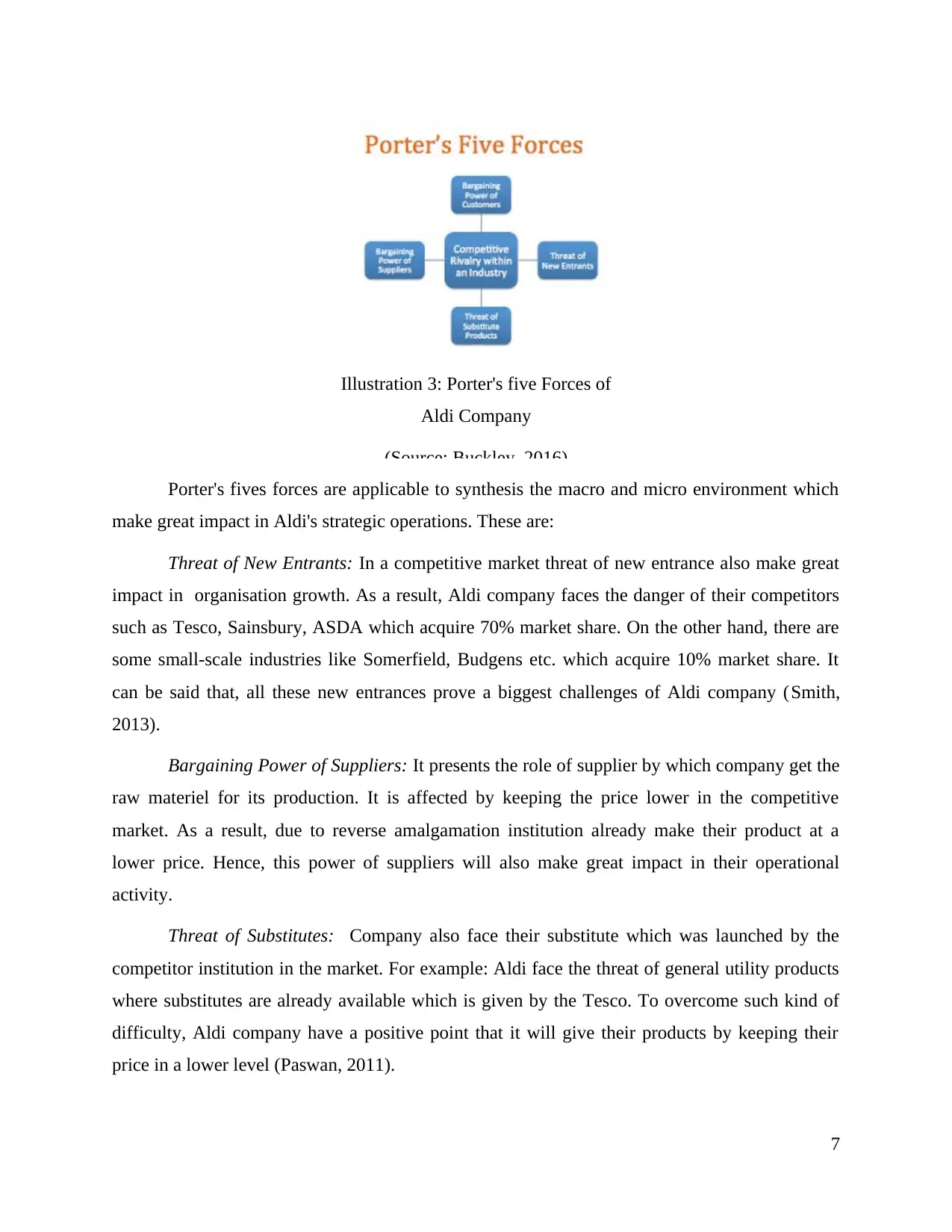
Illustration 3: Porter's five Forces of
Aldi Company
(Source: Buckley, 2016)
Porter's fives forces are applicable to synthesis the macro and micro environment which
make great impact in Aldi's strategic operations. These are:
Threat of New Entrants: In a competitive market threat of new entrance also make great
impact in organisation growth. As a result, Aldi company faces the danger of their competitors
such as Tesco, Sainsbury, ASDA which acquire 70% market share. On the other hand, there are
some small-scale industries like Somerfield, Budgens etc. which acquire 10% market share. It
can be said that, all these new entrances prove a biggest challenges of Aldi company (Smith,
2013).
Bargaining Power of Suppliers: It presents the role of supplier by which company get the
raw materiel for its production. It is affected by keeping the price lower in the competitive
market. As a result, due to reverse amalgamation institution already make their product at a
lower price. Hence, this power of suppliers will also make great impact in their operational
activity.
Threat of Substitutes: Company also face their substitute which was launched by the
competitor institution in the market. For example: Aldi face the threat of general utility products
where substitutes are already available which is given by the Tesco. To overcome such kind of
difficulty, Aldi company have a positive point that it will give their products by keeping their
price in a lower level (Paswan, 2011).
7
Aldi Company
(Source: Buckley, 2016)
Porter's fives forces are applicable to synthesis the macro and micro environment which
make great impact in Aldi's strategic operations. These are:
Threat of New Entrants: In a competitive market threat of new entrance also make great
impact in organisation growth. As a result, Aldi company faces the danger of their competitors
such as Tesco, Sainsbury, ASDA which acquire 70% market share. On the other hand, there are
some small-scale industries like Somerfield, Budgens etc. which acquire 10% market share. It
can be said that, all these new entrances prove a biggest challenges of Aldi company (Smith,
2013).
Bargaining Power of Suppliers: It presents the role of supplier by which company get the
raw materiel for its production. It is affected by keeping the price lower in the competitive
market. As a result, due to reverse amalgamation institution already make their product at a
lower price. Hence, this power of suppliers will also make great impact in their operational
activity.
Threat of Substitutes: Company also face their substitute which was launched by the
competitor institution in the market. For example: Aldi face the threat of general utility products
where substitutes are already available which is given by the Tesco. To overcome such kind of
difficulty, Aldi company have a positive point that it will give their products by keeping their
price in a lower level (Paswan, 2011).
7
Paraphrase This Document
Need a fresh take? Get an instant paraphrase of this document with our AI Paraphraser
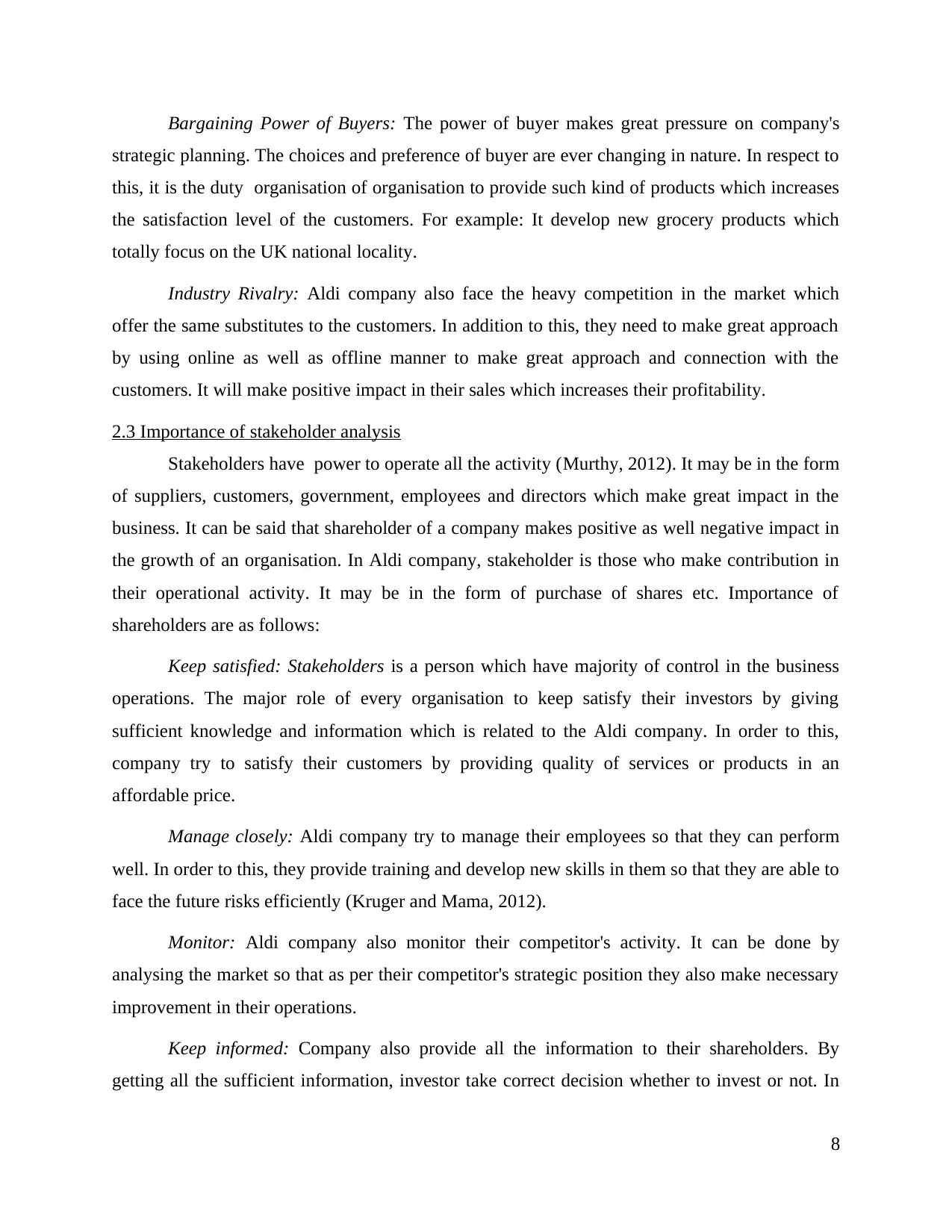
Bargaining Power of Buyers: The power of buyer makes great pressure on company's
strategic planning. The choices and preference of buyer are ever changing in nature. In respect to
this, it is the duty organisation of organisation to provide such kind of products which increases
the satisfaction level of the customers. For example: It develop new grocery products which
totally focus on the UK national locality.
Industry Rivalry: Aldi company also face the heavy competition in the market which
offer the same substitutes to the customers. In addition to this, they need to make great approach
by using online as well as offline manner to make great approach and connection with the
customers. It will make positive impact in their sales which increases their profitability.
2.3 Importance of stakeholder analysis
Stakeholders have power to operate all the activity (Murthy, 2012). It may be in the form
of suppliers, customers, government, employees and directors which make great impact in the
business. It can be said that shareholder of a company makes positive as well negative impact in
the growth of an organisation. In Aldi company, stakeholder is those who make contribution in
their operational activity. It may be in the form of purchase of shares etc. Importance of
shareholders are as follows:
Keep satisfied: Stakeholders is a person which have majority of control in the business
operations. The major role of every organisation to keep satisfy their investors by giving
sufficient knowledge and information which is related to the Aldi company. In order to this,
company try to satisfy their customers by providing quality of services or products in an
affordable price.
Manage closely: Aldi company try to manage their employees so that they can perform
well. In order to this, they provide training and develop new skills in them so that they are able to
face the future risks efficiently (Kruger and Mama, 2012).
Monitor: Aldi company also monitor their competitor's activity. It can be done by
analysing the market so that as per their competitor's strategic position they also make necessary
improvement in their operations.
Keep informed: Company also provide all the information to their shareholders. By
getting all the sufficient information, investor take correct decision whether to invest or not. In
8
strategic planning. The choices and preference of buyer are ever changing in nature. In respect to
this, it is the duty organisation of organisation to provide such kind of products which increases
the satisfaction level of the customers. For example: It develop new grocery products which
totally focus on the UK national locality.
Industry Rivalry: Aldi company also face the heavy competition in the market which
offer the same substitutes to the customers. In addition to this, they need to make great approach
by using online as well as offline manner to make great approach and connection with the
customers. It will make positive impact in their sales which increases their profitability.
2.3 Importance of stakeholder analysis
Stakeholders have power to operate all the activity (Murthy, 2012). It may be in the form
of suppliers, customers, government, employees and directors which make great impact in the
business. It can be said that shareholder of a company makes positive as well negative impact in
the growth of an organisation. In Aldi company, stakeholder is those who make contribution in
their operational activity. It may be in the form of purchase of shares etc. Importance of
shareholders are as follows:
Keep satisfied: Stakeholders is a person which have majority of control in the business
operations. The major role of every organisation to keep satisfy their investors by giving
sufficient knowledge and information which is related to the Aldi company. In order to this,
company try to satisfy their customers by providing quality of services or products in an
affordable price.
Manage closely: Aldi company try to manage their employees so that they can perform
well. In order to this, they provide training and develop new skills in them so that they are able to
face the future risks efficiently (Kruger and Mama, 2012).
Monitor: Aldi company also monitor their competitor's activity. It can be done by
analysing the market so that as per their competitor's strategic position they also make necessary
improvement in their operations.
Keep informed: Company also provide all the information to their shareholders. By
getting all the sufficient information, investor take correct decision whether to invest or not. In
8
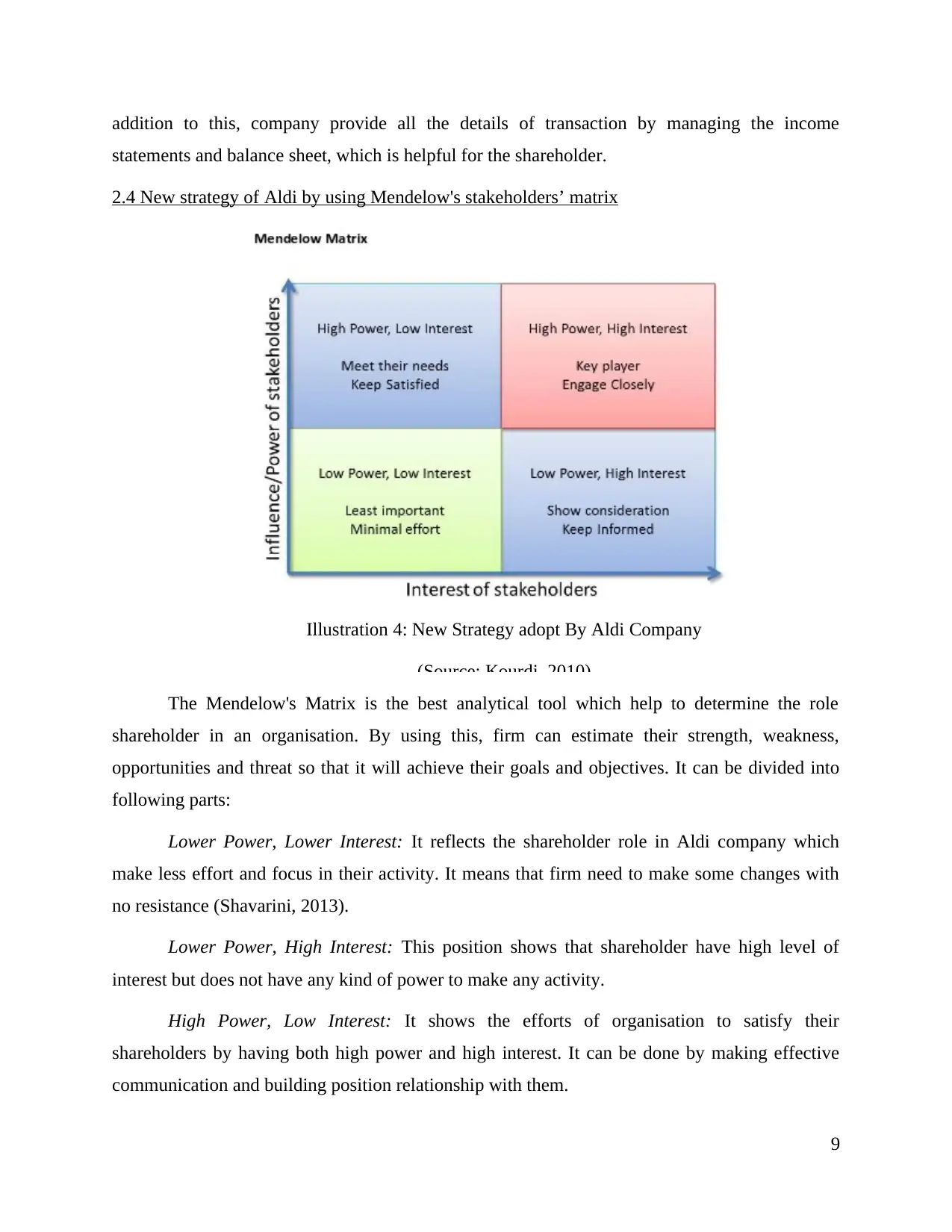
addition to this, company provide all the details of transaction by managing the income
statements and balance sheet, which is helpful for the shareholder.
2.4 New strategy of Aldi by using Mendelow's stakeholders’ matrix
Illustration 4: New Strategy adopt By Aldi Company
(Source: Kourdi, 2010)
The Mendelow's Matrix is the best analytical tool which help to determine the role
shareholder in an organisation. By using this, firm can estimate their strength, weakness,
opportunities and threat so that it will achieve their goals and objectives. It can be divided into
following parts:
Lower Power, Lower Interest: It reflects the shareholder role in Aldi company which
make less effort and focus in their activity. It means that firm need to make some changes with
no resistance (Shavarini, 2013).
Lower Power, High Interest: This position shows that shareholder have high level of
interest but does not have any kind of power to make any activity.
High Power, Low Interest: It shows the efforts of organisation to satisfy their
shareholders by having both high power and high interest. It can be done by making effective
communication and building position relationship with them.
9
statements and balance sheet, which is helpful for the shareholder.
2.4 New strategy of Aldi by using Mendelow's stakeholders’ matrix
Illustration 4: New Strategy adopt By Aldi Company
(Source: Kourdi, 2010)
The Mendelow's Matrix is the best analytical tool which help to determine the role
shareholder in an organisation. By using this, firm can estimate their strength, weakness,
opportunities and threat so that it will achieve their goals and objectives. It can be divided into
following parts:
Lower Power, Lower Interest: It reflects the shareholder role in Aldi company which
make less effort and focus in their activity. It means that firm need to make some changes with
no resistance (Shavarini, 2013).
Lower Power, High Interest: This position shows that shareholder have high level of
interest but does not have any kind of power to make any activity.
High Power, Low Interest: It shows the efforts of organisation to satisfy their
shareholders by having both high power and high interest. It can be done by making effective
communication and building position relationship with them.
9
⊘ This is a preview!⊘
Do you want full access?
Subscribe today to unlock all pages.

Trusted by 1+ million students worldwide
1 out of 19
Related Documents
Your All-in-One AI-Powered Toolkit for Academic Success.
+13062052269
info@desklib.com
Available 24*7 on WhatsApp / Email
![[object Object]](/_next/static/media/star-bottom.7253800d.svg)
Unlock your academic potential
Copyright © 2020–2025 A2Z Services. All Rights Reserved. Developed and managed by ZUCOL.





